![]()
![]()
![]()
Use LEFT and RIGHT arrow keys to navigate between flashcards;
Use UP and DOWN arrow keys to flip the card;
H to show hint;
A reads text to speech;
66 Cards in this Set
- Front
- Back
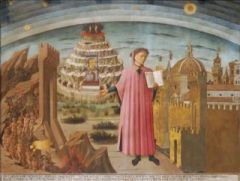
|
fres·co (frĕs’kō)
A noun refering to a water-color painting on wet plaster walls. The damp plaster is painted with pigments mixed with water or lime water. The color dries lighter and becomes integrated into the wall or ceiling. |
|
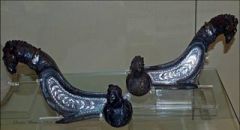
|
fulcrum (fǒǒl’kr-krəm)
pl. fulcra Fulcra are decorative pieces which attach to the side of the head and foot-boards used in Greek and Roman furniture, usually coaches and/or beds. They are commonly made of bronze or metal and are often engraved and extravagantly decorated with depictions of gods and goddesses. |
|
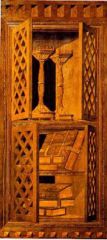
|
Marquetry (mär'kə trē)
Marquetry is the craft of covering a structural carcass with pieces of veneer forming decorative patterns, designs or pictures. Marquetry uses contrasting woods or other materials, which are inlaid into veneered wood, especially on case furniture. |
|
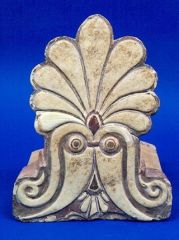
|
Anthemion (an thē' mē ən)
A classic Greek and Roman ornamental motif, based on a palm or honeysuckle leaf, of floral forms radiating from a single point, often with a symmetrical pair of “s” scrolls at the base. |
|
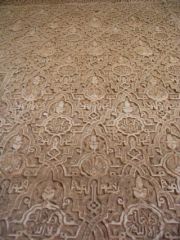
|
Arabesque (ar'ə besk')
An elaborate ornamental design of repeating geometric forms and intertwining lines based on plants and sometimes also based on animals. It is often used in carvings, paintings and inlaid work, and it is found on the walls of mosques to symbolize the infinite nature of creation. |
|
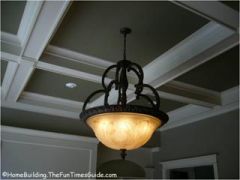
|
Coffer (kôf' ər)
A sunken or recessed panel within a vault, soffit or ceiling, most often constructed in a square or octagonal shape. |
|
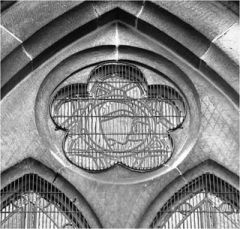
|
Cinquefoil (siŋk'foil)
An ornamentation comprised of five lobes, or petals, that radiate from a center point and are separated by cusps. It was a motif used in Gothic tracery. |
|
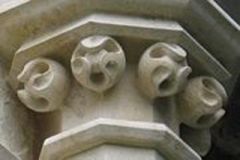
|
Ball Flower (bôl'flou'ər)
A carved, spherical Gothic ornament with a 3-lobed petal effect in the center. They are often placed in the hollow part of molding. |
|

|
Bead and Reel
A decoration found on molding alternating half round beads with oval shapes. It is commonly found on medieval architecture. Many times it was used as ornamentation near the top of columns, as well as in molding. |
|

|
Bucranium (byuˈkreɪniəm)
A decorative motif in classical Roman architecture representing an ox killed in religious sacrifice. It sometimes appeared on friezes. |
|
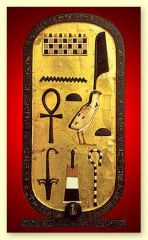
|
Cartouche (kär tōōsh')
An oval frame enclosing the ancient Egyptian hieroglyphics that contain characters expressing the names or epithets of royal or divine personages, as well as for the amulet of similar design worn in ancient Egypt as a protection against the loss of one’s name. |
|

|
Lozenge (läz' ənj)
A lozenge (◊), also known as a diamond, is a form of rhombus. The definition of lozenge is not strictly fixed, and it is sometimes used simply as a synonym (from the French losange) for rhombus. Most often, though, lozenge refers to a thin rhombus — a rhombus with acute angles of 45°. The lozenge shape is often used in parquetry and as decoration on ceramics, silverware and textiles. |
|
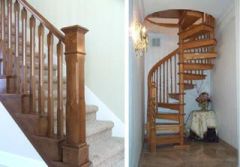
|
Newel (nōō'əl)
1. The post at the top or bottom of a flight of stairs; it supports the handrail. 2. The central pillar of a circular staircase |
|
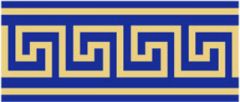
|
Greek Key
An ornamental pattern consisting of repeated vertical and horizontal lines (often in relief). A Greek Key is a decorative border constructed from a continuous line, shaped into a repeated motif. |
|
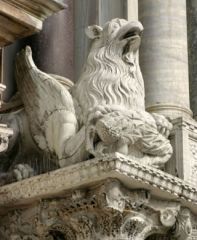
|
Griffin (grif'in)
A decorative device in the shape of a monster with the body of a lion and the head and wings of an eagle. Griffins often appear on friezes and were popular in Gothic architecture. |
|
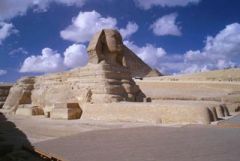
|
Sphinx (sfingks)
An imaginary creature that combines a woman's head and bust with the body of a lion. Wings were added to the sphinx during the Roman era. |
|
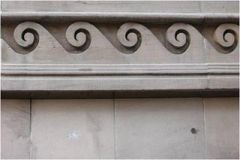
|
Wave Pattern (wāv pa-tərn)
A continuous horizontal band made up of conventionalized wave crests. It is also called a wave scroll or Vitruvian scroll. While the wave pattern originated with the Egyptians, it is more typically associated with Greek or Roman ornament. This pattern, resembling loosely rolled parchment, is commonly seen as a frieze ornament. |
|
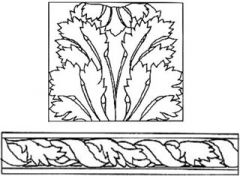
|
Acanthus (ə kan'thəs)
An architectural ornament that represents the foliage or leaves of the acanthus. It appears in the capitals of Corinthian columns. |
|
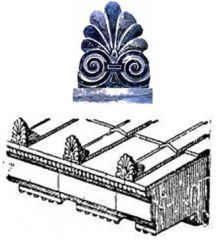
|
Antefix (an'ti fiks')
An upright ornament at the eaves of a tiled roof, to conceal the foot of a row of convex tiles that cover the joints of the flat tiles. Also, an ornament above the top molding of a cornice. It is usually represented as a motif resembling a fanned out leaf. It originated in Greek and Roman architecture. |
|
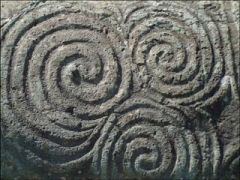
|
Spiral Pattern (spī'rəl pa-tərn)
A consistent or characteristic arrangement running continuously around a fixed point or center, never backtracking on itself. |
|
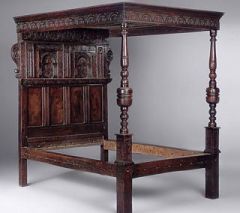
|
Tester (tes'tər)
A canopy on a four-post or draped bed. Originally the tester was a flat wooden canopy, paneled and carved and was used as a roof for four-post Tudor and Stuart bedsteads. Later, it became a wooden frame draped and swathed with valences and finally a small wood cornice with a fabric valence and curtains. |
|
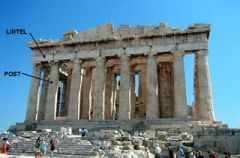
|
Trabeated System (trā'bē āt'id)
A system of construction using upright posts, columns or piers supporting horizontal beams or lintels that span the space between them. It is also called post and lintel, or post and beam. |
|
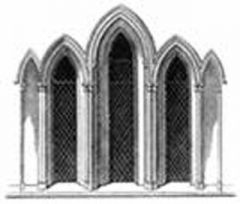
|
Lancet Window (lan'sit)
The lancet arch is a variety of pointed arch in which each of the arcs, or curves, of the arch have a radius longer than the width of the arch. It takes its name from being shaped like the tip of a lance. The lancet window is one of the typical features of the Early English (13th century) period in Gothic architecture. |
|
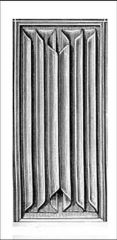
|
Linenfold Motif (lin'ən fōld)
A Gothic decorative motif in the form of a folded piece of linen cloth, usually carved in low relief. Also know as parchment panels. . |
|
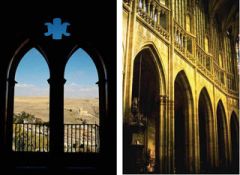
|
Ogee Arch (ō'jē' ärch)
A pointed arch having an S-shape on both sides. The ogee is created by the union of a concave and a convex arch. The result looks a bit like an S. It was popular in the Gothic Period and is also called a keel arch. It is used at the top of arches, in windows and above doorways as decoration. |
|
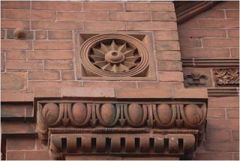
|
Egg-and-Dart (ěg'ən-därt')
A decorative molding consisting of a series of egg-shaped figures alternating with dart-shaped, anchor-shaped or tongue-shaped figures. The origin of the Egg-and Dart dates back to Ancient Greek architecture and was also used by the Romans. |
|
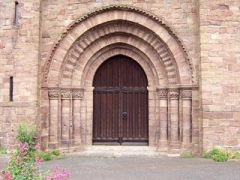
|
Dog-Tooth (dôg tōōth)
A form of ornamentation used in Early English Gothic architecture. The pattern consists of four flower petals forming a square or diamond shape with a central element. The petals resemble canine teeth. |
|
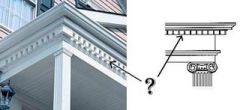
|
Dentil Molding (den'til)
A series of small equidistant, projecting rectangular blocks in a cornice. It appears in Ionic and Corinthian cornices. Dentil molding is made up of dentils, closely spaced tooth shaped rectangular blocks that form a molding. |
|
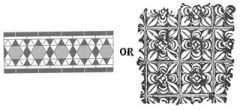
|
Diaper Pattern (dī'pər)
An allover or repeating pattern without definite limits, applied as decoration to a plain surface. Often the area contain lattices and floral, or geometric designs set into boxes. It is used on walls, wallpapers, cabinet enrichments, etc. |
|

|
Guilloche (gĭ-lōsh', gē-yōsh')
A geometric band, continuous in nature, of interlacing circular forms giving the impression of a loosely twisted rope. The interstices are sometimes filled with other motifs. Ancient Greeks used the motif in architecture, but it figured prominently in later design periods. On furniture the carved motif was used on such areas as the frieze of tables and case pieces, the seat rail of chairs, etc. |
|
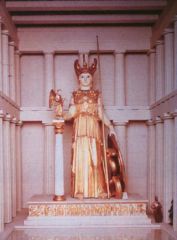
|
Pheidias or Pheidias (both: fid'ēus)
He was one of the greatest sculptors of ancient Greece. His greatest achievements were the Athena Parthenos at Athens and the Zeus in the temple of Olympia, The Athena (dedicated in the Parthenon c.447–439 B.C.) was the chief treasure of Athens. It was destroyed in antiquity, but several copies are preserved |
|
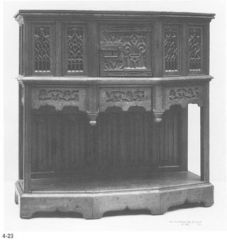
|
Credenza (kri den'zə)
A table or surface whereby foods for the nobility were tested for poison. It was used both for a table placed near the dining table and for storage concealed by doors. The credenza was placed on a stand with paneled back and a shelf near the floor. |
|
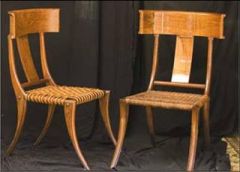
|
Klismos (klɪzmɒs)
A type of chair developed and perfected by Greek craftsmen. Its characteristics included horizontally curved back placed at shoulder height, supported by three uprights- two stiles and an intermediate splat. |
|
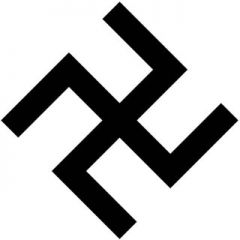
|
Swastika (swäs'ti kə)
An ancient cosmic or religious symbol formed by a Greek cross with the ends of the arms bent at right angles in either a clockwise or a counterclockwise direction. Until the Nazis used this symbol, the swastika was used by many cultures throughout the past 3,000 years to represent life, sun, power, strength and good luck. |
|
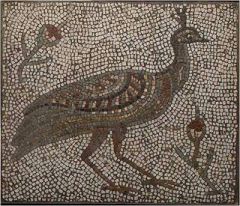
|
Tessera (tes'ɘr ɘ)
Plural- tesserae One of the small squares of stone or glass used in making mosaic patterns. In antiquity, mosaics were formed from naturally colored pebbles, but by 200 BCE purpose-made tesserae were being used. Marble or limestone was cut into small cubes that were arranged into the design. Later, tesserae were made from colored glass, or clear glass backed with metal foils. |
|
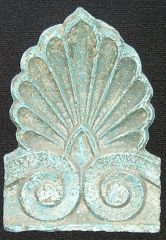
|
Palmette (pāl-mět')
A stylized palm leaf used as a decorative element, notably in Persian rugs and in classical moldings, reliefs, frescoes and vase paintings. |
|
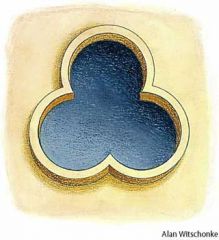
|
Trefoil (trēʹfoil')
A three lobed, clover-like ornament used with Gothic tracery and decoration. The three arcs are separated by the cusps. The Gothic symbol for the Holy Trinity. |
|
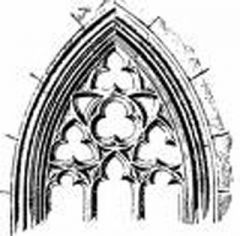
|
Tracery (trās'ɘr ē)
Originally the stone mullions in Gothic windows. A decorative form composed of circles with arcs formed by the intersection of circles. Thus every line is either a circle or the broken arc of a circle, and the composition of these elements makes for intricate patterns. |
|

|
Trompe L’oeil (trōmp lë'y')
French for "deceive the eye." A polished technique of using pictorial elements, perspective, foreshortening and shadows to render objects in paint or inlay so realistically that they appear to be actually three-dimensional. The Italian form of trompe l’oeil is called quadrature. |
|

|
Tympanum (tim'pə nəm)
The triangular surface of a pediment bounded by the lower molding and the sloping sides. |
|
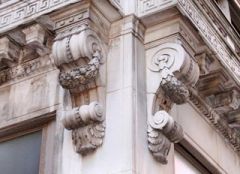
|
Corbel (kôr'bɘl)
In architecture, a bracket or shoulder set in a wall to carry a beam. Corbels were originally found on the exteriors of buildings, but were modified to work in the interior as well. Interior uses may include fireplace mantles, ventilation hoods, center islands, etc. |
|
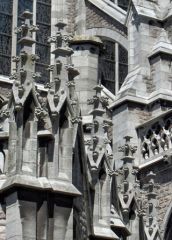
|
Crocket (kräk'it)
A projecting carved ornament used on the side of pinnacles and spires, often bud- or leaf shaped. A crocket was typically found on the exteriors of Gothic architecture but could also be found in Gothic art. This motif can be found incorporated into English Gothic revival furniture in the 19th century. |
|
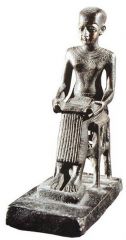
|
Imhotep (Im·ho·tep)
Considered the first Egyptian architect, physician, and sage known by name. He was worshiped as a God. He designed and built first Egyptian Pyramid: the Pyramid of Djoser (the Step Pyramid). He may have also been responsible for the first known use of columns in architecture. |
|
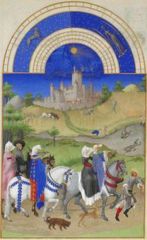
|
Limbourg Brothers (lim'bʉrg)
The Limbourg Brothers (active in the 15th century) were Dutch illuminators. They were among the first to render specific landscape scenes with accuracy. The three brothers entered the service of the Duke de Berry, for whom they produced a book of hours (private prayer book) known as the Très Riches Heures du Duc de Berry. Since the brothers worked together, it is difficult to distinguish individual styles. They synthesized the achievements of their contemporaries into a style characterized by tall, aristocratic figures with lavish, curvilinear draperies and by naturalistic seasonal landscapes and scenes of peasant life. Their work determined the course of early Dutch art. |
|
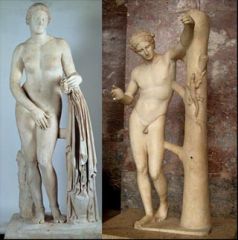
|
Praxiteles (prak sit'ə lēz')
Renowned Greek sculptor of the 4th Century B.C. He flourished from 370-330 B.C. His work was done almost entirely in marble, and he was the first Greek sculptor to represent the female nude in sculpture. |
|
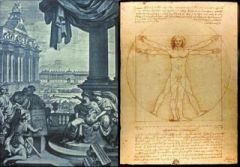
|
Marcus Vitruvius Pollio (və-trü-vē-əs)
Roman architect, writer and theorist who was active from 46 to 30 B.C. His ten volume work, De Architectura, is the only complete discourse on architecture from antiquity. The manuscript was not used widely in his own time but was extremely influential during Renaissance. |
|
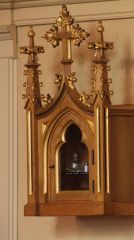
|
Ambry (am'brē)
In ecclesiastic work, the ambry or aumbry was a small cupboard used to hold the sacred vessels, books and alter linens. Also called an almery. |
|
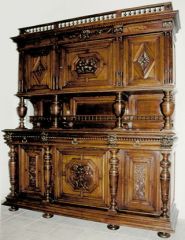
|
Buffet (bɘ fā')
A cupboard or sideboard. A side table sometimes with cupboards or shelves. Early Renaissance buffets resembled medieval cupboards and were supported on bases. The entire piece was usually decorated with columns, medallions and arabesques. |
|
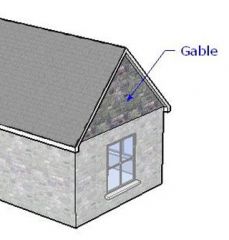
|
Gable (gā'bɘl)
A gable is the triangular section of an exterior wall that extends from the top of the exterior walls to the peak of the triangle. A pediment is a type of gable. |
|
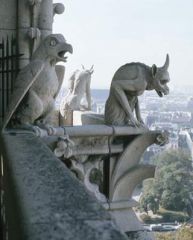
|
Gargoyle (gär'goil')
A gargoyle is a water sprout designed to drain water from a parapet gutter. These figures are typically restricted to the grotesque figures such as a bird or beast of from the Gothic period. Gargoyles typically sit haunched on the back of a cornice moulding and project several feet in order to throw the water far from the building. |
|

|
Rinceau (rin sō)
An ornamental band of scrolled foliage, usually vine leaves. A rinceau is sometimes known as an arabesque. They are usually in a horizontal position on such surfaces as a panel, frieze or other architectural features. They are often combined with cartouches and grotesques. |
|
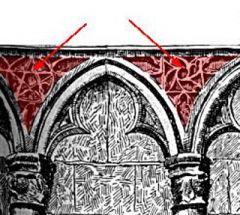
|
Spandrel (span'drəl)
The triangular piece which spans between a vertical support and horizontal rail or spans between two arches. |
|
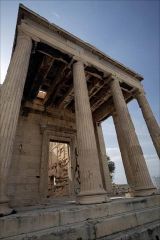
|
Portico (pôr'ti kō')
An open space covered with a roof supported on columns. A porch-like structure in front of a building which is fronted with columns. |
|
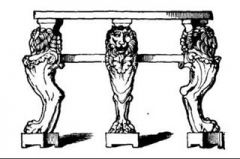
|
Quadruped (kwä-drə ped')
A Roman table leg form derived from an animal having four feet; It depicts the head, chest, leg and paw of a lion. |
|
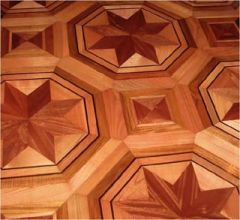
|
Parquetry (pär-kə-trē)
Work in the form of geometrically patterned wood laid or inlaid. It is especially used for floors. |
|
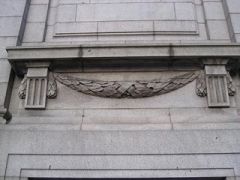
|
Festoon (fes·tōōn)
A string or chain of flowers, foliage, ribbon, etc. suspended in a curve between two points. They can be represented architecturally. |
|

|
Finial (fin'ē·əl)
Finials are usually placed to “end” something such as a post on a piece of furniture, or at the tops of gables or similar structures. |
|
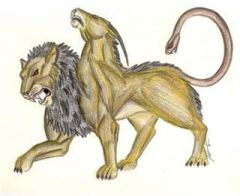
|
Chimera (kī mir'ə)
A mythical, dragon-like animal, or composite, part human, part animal, used in decoration. Used for legs or furniture supports in the Renaissance, Empire and later 19th century designs. |
|
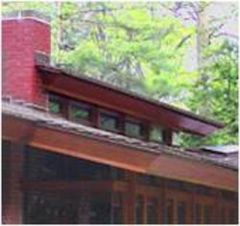
|
Clerestory Window (klir'stôr'ē)
A window placed near the top of the wall, originally, above an adjacent roof. The clerestory probably originated in the temples of Egypt. There use continued through the Greeks and they are still used today. |
|

|
Pilaster (pi las'tər)
A shallow relief pier generally treated as a flat column in relief on a wall surface. They serve no structural purpose, but are used for rhythm or to articulate a space and /or frame elements, particularly openings. An essential element of Classical Roman and Renaissance architectural design. |
|
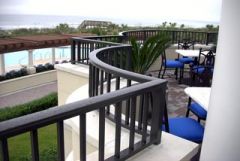
|
Parapet (pār'ə-pĭt, -pět‘)
A parapet is a wall-like barrier at the edge of a roof or structure that was primarily designed as a defensive feature. However, now it is often used as a protection against unwanted falls and for constructional or stylistic features. |
|
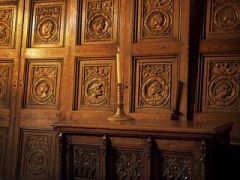
|
Romayne Work (rō mān')
A medallion within which is carved a head in profile. It was a Jacobean and Restoration period adaptation of Renaissance details. |
|
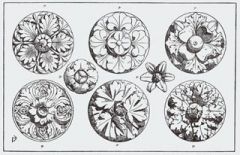
|
Rosette (rō zet')
A floral ornamental motif that is circular in nature, petals or leaves radiating from central point. Circular, elliptical or square outer contour. The design is derived from the natural form of a rosette in botany. They are used as an ornamental motif for architectural and furniture pieces and are often carved into wood or stone. |
|

|
Water Leaf Pattern (wȯ-tər-lēf, ‘wä, pa-tərn)
An ornamental motif which resembles an elongated laurel leaf and is often used to enrich a cyma reversa molding. The water leaf was usually represented in a low-relief carving on moldings. |
|

|
Caryatid (kār'ē-at'ĭd)
This term describes the sculptural supports that take the female form. They can be either structural or decorative supports in both interiors and exteriors of buildings. This term originated in ancient Greek design, and was used in structures such as the porch of the Erechtheion on the Acropolis. It was also used in Roman design in structures such as the Pantheon. |
|
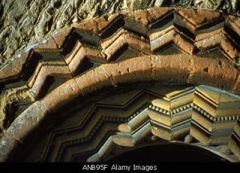
|
Chevron (shev'rən)
The general shape of a V character, or a triangular shape facing either up, or more commonly, down. It is a simple, geometric form that can be altered to create many different designs. This pattern originated in early art designs and pottery paintings. These early art forms were found in the areas of Crete and Greece. |

